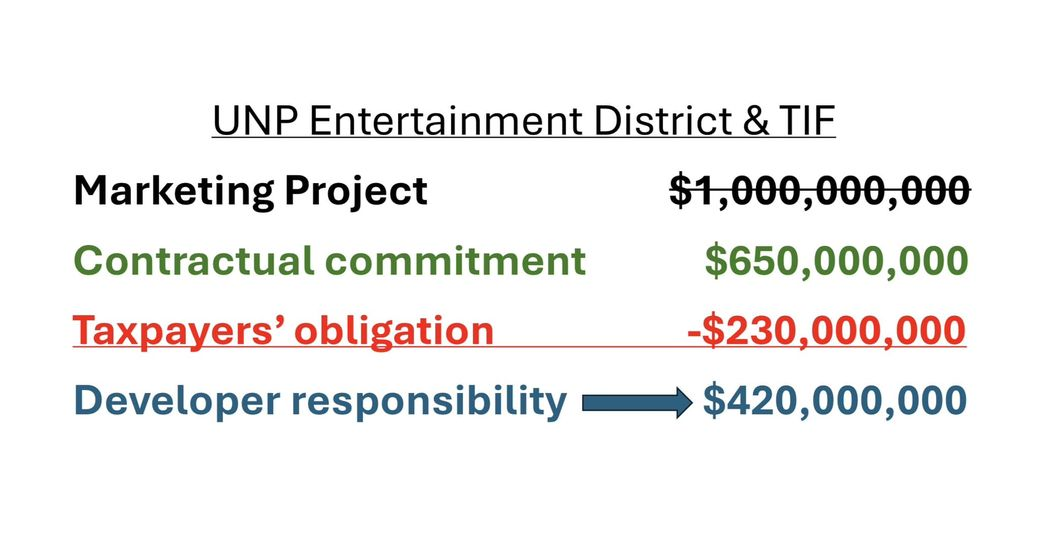Over 11,000 Norman residents signed a petition to put the Arena TIF (Rock Creek Entertainment District TIF) to a public vote. The referendum gist has been challenged on the grounds that it misleads the public about the nature of the project. The gist describes the ordinance that created the project. It is supposed to be a brief summary of the item that is to be put to a public vote.
In this blog, I note the extensive campaign by Arena PROPONENTS with misleading information about the Arena TIF project. There is a big disjoint between what is described in the project plan and what is contractually required in the Economic Development Agreement. The presentations made to City advisory committees were not consistent with the Economic Development Agreement contract. Even the presentation given at the public hearing was misleading and omitted key information.
To start, we can look at the presentation given to the City of Norman Planning Commission in June of 2024.
Advisory committees, including the Planning Commission, were shown inflated numbers for the project plan. The plan in the Economic Development Agreement that was approved are much smaller than what the developers presented to advisory committees, city council, and the public.
The Development Agreement indicates only $420 million in private capital investment. There is no penalty if this is not achieved.
The Developers slides do not clarify what is contractually required and what is speculative. The entertainment district activity (retail + hotel) is likely to get built. There is no penalty if it is less than promised. The larger project components are speculative. The Development Agreement indicates that this will "be based on market demand" which removes any minimum requirements. There are not penalties for failure to deliver on promises.
"The Numbers" slide also omits key impacts on taxing jurisdictions. The slide only mentions Cleveland County, but the county only receives about 17% of Ad Valorem revenues. The vast majority of Ad Valorem taxes go to funding schools.

The Developer's slides suggested that nothing would happen in the Arena TIF district without the TIF financing. This is based on two claims; (1) an existing covenant created with University North Park TIF #2 which includes the Arena TIF district, and (2) the undeveloped status of the land.
The covenant which limits retail north of Rock Creek was part of the original University North Park TIF (#2) to protect retail investments from cannibalization. The Arena plan is a way to renegotiate with landowners in the UNP TIF #2 to allow more retail competition. Hotel, office, and residential housing are NOT restricted and can happen without an Arena and TIF. The covenant also excludes car dealerships but that has been circumvented without an Arena or TIF.
The claim of "no risk" for a project of this size is fantasy. The City would not take on the debt, but tax revenues ARE committed to paying off the financing costs (debt + interest) taken on by the Cleveland County Recreation and Entertainment Authority.
Even if the project goes bankrupt, the City would be obliged to make payments to pay off the debt. The payments are limited to tax revenues collected in the TIF district. The risk is that taxpayers sink hundreds of millions into financing a project that is not completed as planned, burdens the future city (county, and school) budgets, and does not create a positive return on investment.
The additional development would include a hotel, residential housing, commercial office which gets developed without TIF in other parts of Norman. Mixed use development is NOT rare in Norman.
TIF obviously benefits some individuals, including landowners, developers, bankers, consultants, lawyers with direct financial interests in TIF based activity. This does not mean that TIFs are positive. Afterall, investors don't profit from all investments. Research suggests that TIF commonly fails to deliver positive economic development. (Merriman 2018 Improving Tax Increment Financing (TIF) for Economic Development - Lincoln Institute of Land Policy).
The claim that the land won't develop without an Arena TIF project is also dubious. The reports (Hunden, HVS) analyzing the project ALL conclude that a significant amount of development is likely to occur on that land without the Arena TIF project.
A PATTERN OF MISLEADING STATEMENTS
In an email exchange, the City of Norman Finance Director recommended that the developers "Be Honest" about the likely negative impact on the City budget and the Reverse Robin Hood effect of the arena TIF.



















